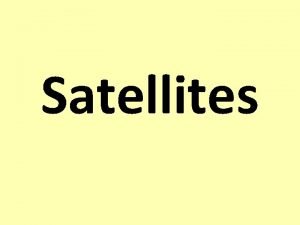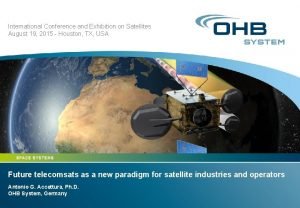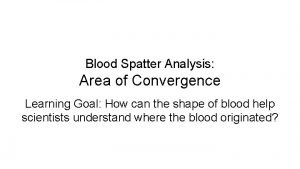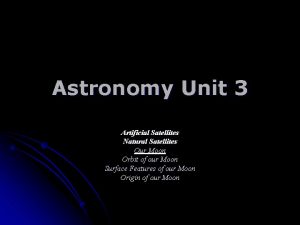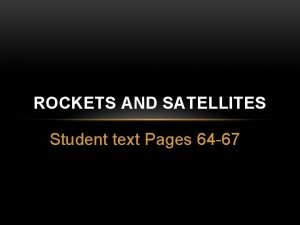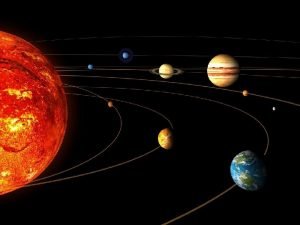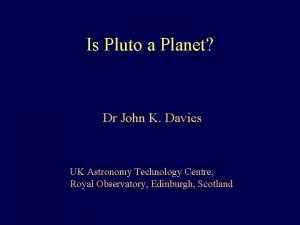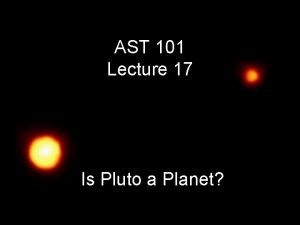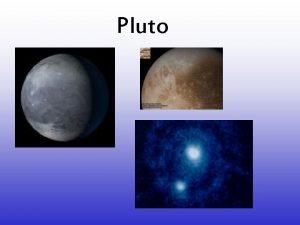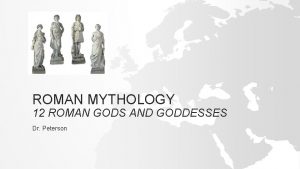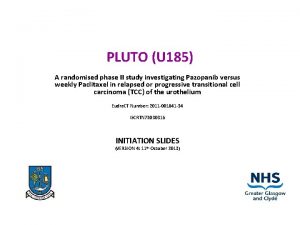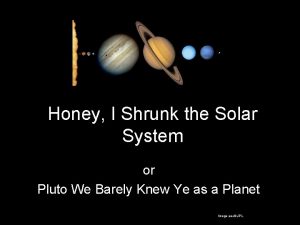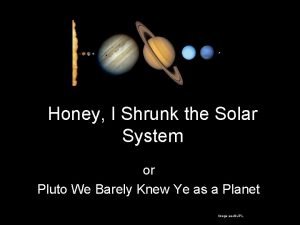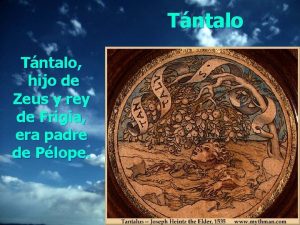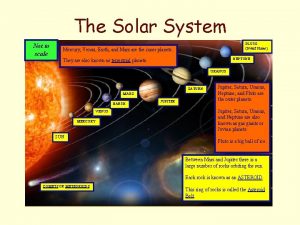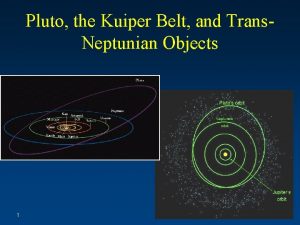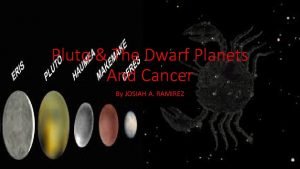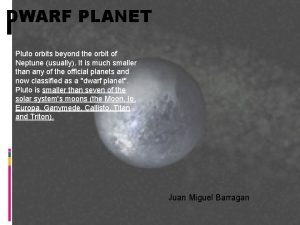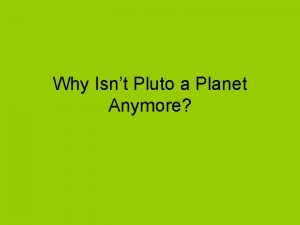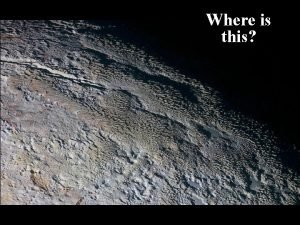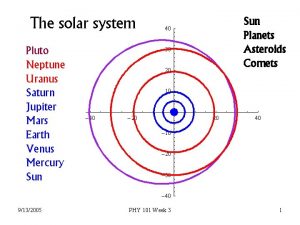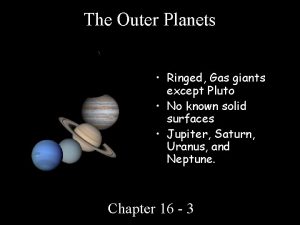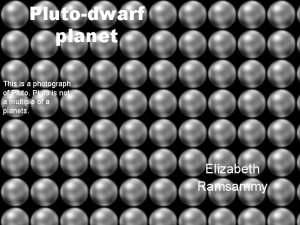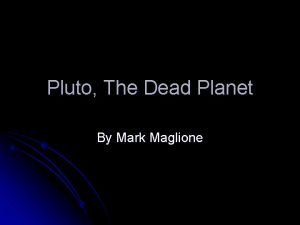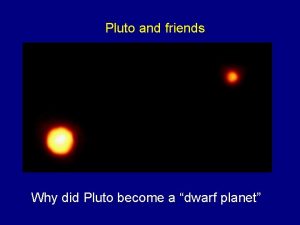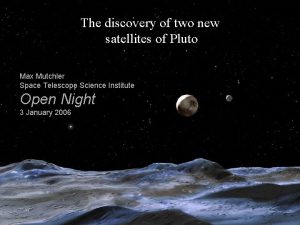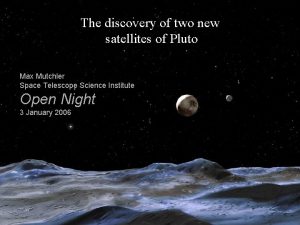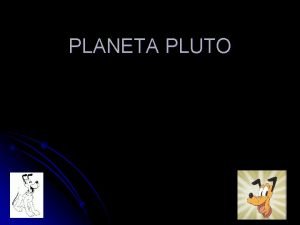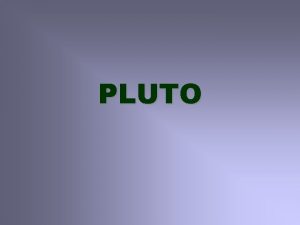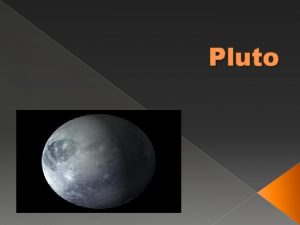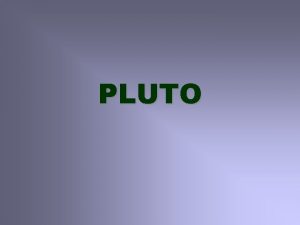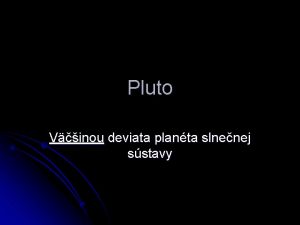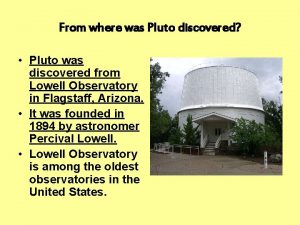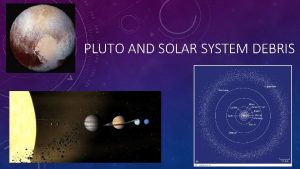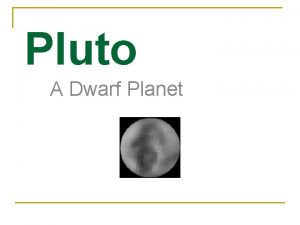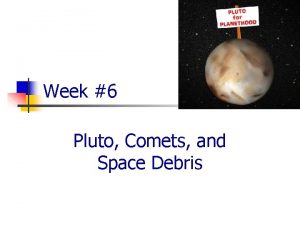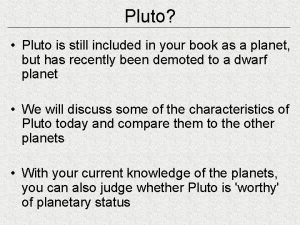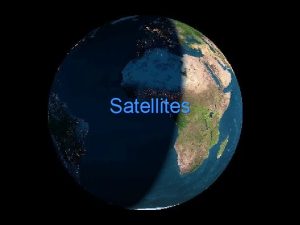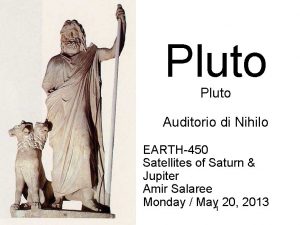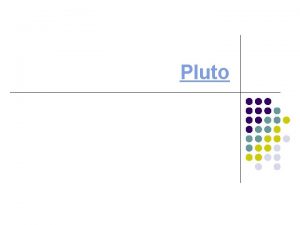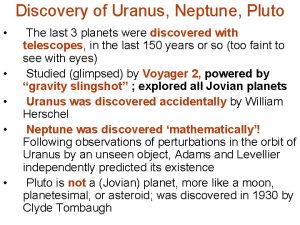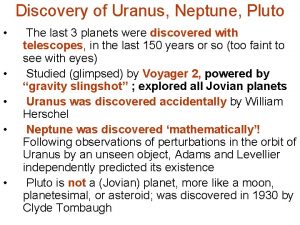The discovery of two new satellites of Pluto


































- Slides: 34

The discovery of two new satellites of Pluto Max Mutchler Space Telescope Science Institute mutchler@stsci. edu New Horizons Educator Workshop 16 January 2006

Overview • Hubble’s Advanced Camera; Discovery team • Discovery of Pluto, Charon, and the Kuiper Belt • Hubble mission support for New Horizons: discovery of two more Pluto satellites • Confirming and following-up the discovery • Implications, and recent related discoveries • More information via the web • Questions? Door prizes!

Calibrating, pointing, and drizzling Hubble Servicing Mission 3 B in March 2002: ACS installed Advanced Camera for Surveys (ACS)

Hubble Pluto Satellite Search Team reporting the discovery to the New Horizons Science Team on November 2, 2005 at the Kennedy Space Center Left to Right: Hal Weaver (JHU/APL), Andrew Steffl (Sw. RI), S. Alan Stern (Sw. RI), Leslie Young (Sw. RI), John Spencer (Sw. RI), Marc Buie (Lowell Observatory), Bill Merline (Sw. RI), Max Mutchler (STSc. I), and…Eliot Young (Sw. RI)

The discovery of Pluto in 1930, and confirmation Clyde Tombaugh

The discovery of Pluto’s moon Charon in 1978 James Christy & Robert Harrington U. S. Naval Observatory Washington, D. C.

Discovery of the Kuiper Belt in 1992

Discovery of two new moons of Pluto Press release image for new moons: the discovery was surprisingly easy for Hubble with ACS… but not quite as easy as it looks here.

New satellite discovery observations • Hubble proposal designed by Weaver, Stern, et al. , initially rejected, then accepted when STIS died • Advanced Camera for Surveys (ACS) Wide Field Channel (WFC) covers entire orbital stability zone • Pluto-Charon near chip gap: peek-a-boo! • 4 long exposures on May 15 and May 18, 2005, using only 2 orbits • Discovery on June 15: try it yourself…

Notice the star trails, cosmic rays, chip gap… 15 May 2005, frame 1

Notice the star trails, cosmic rays, chip gap… 15 May 2005, frame 2

Dithering across the chip gap now…see anything? 15 May 2005, frame 3

Dithering across the chip gap now…see anything? 15 May 2005, frame 4

Looking for real objects among all the artifacts… 15 May 2005, sum 4 frames

Looking for real objects among all the artifacts… 15 May 2005, median 4 frames

Do it again 3 days later…where are the moons? 18 May 2005, frame 1

Do it again 3 days later…where are the moons? 18 May 2005, frame 2

Dither across the gap…where are the moons? 18 May 2005, frame 3

Do it again 3 days later…where are the moons? 18 May 2005, frame 4

“Clean” image 18 May 2005, median 4 frames

“Clean” image 15 May 2005, median 4 frames

New moons are roughly 3 -4 x farther out than Charon, with possible 6: 4: 1 orbital resonances S/2005 P 1 Charon S/2005 P 2 15 and 18 May 2005, median 8 frames

Initial thoughts • Why is Pluto suddenly going so easy on us ? !? • Well-designed program: long exposure times (but not too long), two epochs…the gap is OK • Two objects! They somewhat validate each other, and assumptions about their orbits • Surprised they are so close to Pluto and Charon: expecting any moons to be farther out, but they don’t violate dynamical constraints (Stern, 1994) • Could they be something other than moons?


Confirmation and follow-up • • Independent discovery in Aug 2005 by Andrew Steffl Search other existing data: Hubble, Subaru… Hubble follow-up: impossible until 15 Feb 2006 (2 gyros) Ground-based attempts to image the new moons in Sep/Oct: Keck, VLT, Gemini (difficult until spring 2006) • Checklist of alternate explanations: rule them out? • Confident enough to announce on 31 October 2005

The “checklist” of possible explanations • • • Detector artifacts? Optical “ghosts” or scattered light? Overlapping cosmic rays or star trails? Real, but asteroids? KBOs (Plutinos)? New moons of Pluto!

Preliminary assumptions and implications • Orbits are co-planar with Charon, nearly circular, possibly in stable resonances with each other • No other moons of similar magnitude (unless artifacts hid them); very compact system • Pluto first KBO with multiple satellites: implies there are probably many more • Probably formed primordially with Charon (collision), not later (captured)

Relative sizes of Pluto, Charon, and new moons (P 1 and P 2) P 1 P 2 2300 km 1200 km New moons are roughly 12 x smaller than Charon, and 5000 x fainter than Charon ~100 km

What does a “quadruple planet” look like? http: //www. stsci. edu/~mutchler/pluto_50. html Animation produced with Celestia

“Xena & Gabrielle” The 10 th planet ?

Xena Pluto Moon Earth

Should we call Pluto a planet? • I’m neutral. But some things to consider… • Is Pluto just the first of many Kuiper Belt “ice dwarf” planets discovered? • Is larger Xena the 10 th planet? • Are slightly smaller Sedna, Quaoar planets? • Ceres was called a planet for ~50 years, then re -classified as an asteroid (a precedent) • Will we have only 8 planets, or hundreds of them? • Is this a problem? Seems like progress to me. • The IAU is working on it…in the meanwhile, it is a harmless and healthy “non-controversy”

Voyagers Good luck to New Horizons, the next great Voyage of Discovery… It will surely inspire the next generation of math and science students. It’s greatest discoveries will surely be the unexpected ones. Launched in 1977

Questions? … AND TWO LITTLE MOONS ! http: //www. boulder. swri. edu/plutonews http: //www. stsci. edu/~mutchler/pluto_50. html http: //pluto. jhuapl. edu http: //hubblesite. org
 Solar power satellites and microwave power transmission
Solar power satellites and microwave power transmission Use of polar satellite
Use of polar satellite Exhibition for satellites
Exhibition for satellites Blood activity - area of convergence
Blood activity - area of convergence Natural satellite of earth
Natural satellite of earth Satellites in orbit around earth continually fall toward
Satellites in orbit around earth continually fall toward San diego sms satellites
San diego sms satellites Steps in psychological research
Steps in psychological research Systematic inquiry aimed at the discovery of new knowledge
Systematic inquiry aimed at the discovery of new knowledge The solar system
The solar system Outer planets
Outer planets Edgeworth
Edgeworth Dante's inferno pluto
Dante's inferno pluto Pluto plus github
Pluto plus github Pluto 101
Pluto 101 Pluto planta
Pluto planta Mercury roman name
Mercury roman name Pluto trial
Pluto trial Pluto planta
Pluto planta How much moons does pluto have
How much moons does pluto have Pluto planta
Pluto planta Rey de frigia
Rey de frigia Pluto planta
Pluto planta Pluto planta
Pluto planta Planets in cancer
Planets in cancer Pluto the person
Pluto the person Pluto inflation
Pluto inflation Dwarf planet symbols
Dwarf planet symbols Why isn't pluto a planet anymore
Why isn't pluto a planet anymore Definition of comet
Definition of comet Pluto planta
Pluto planta Pluto planta
Pluto planta Dysnomnia
Dysnomnia Pluto planta
Pluto planta How did pluto become a dwarf planet
How did pluto become a dwarf planet

